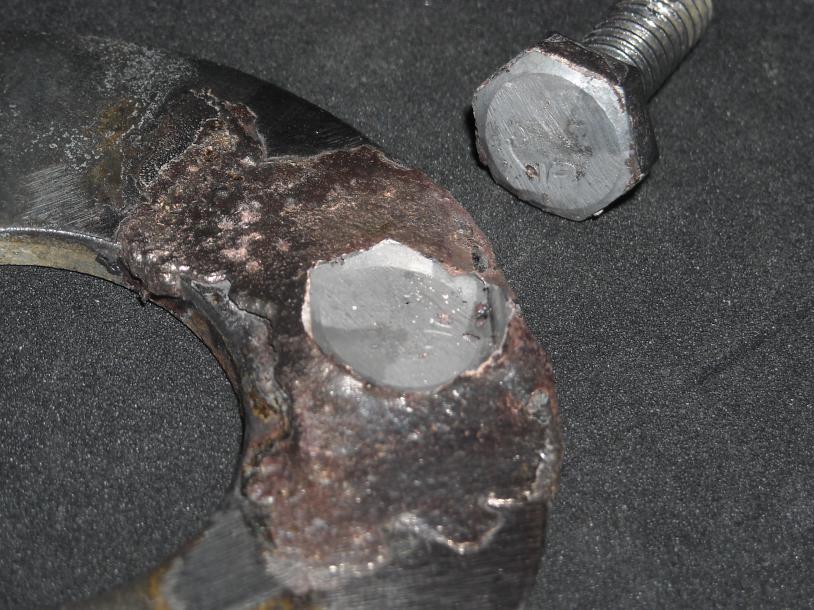Brazing Steel to Steel- Wetting and Penetration Issues
A gentleman posted on Practical Machinist looking for brazing information on his failed attempts at brazing steel-to-steel and get “away from messy stick welding”. Using 56% silver and Harris paste flux with 1100-1700 working degree temperature, he was using a propane torch to braze a steel nut to a washer.
….I will admit, that out of experimentation I have heated the part to bright RED to see if I can flow it further out….it doesn’t work well and….I found that the silver seems to….how can I say this….”peel” off the steel when struck with a hammer….HARDLY MIG weld strength (as it is supposed to be). I cannot let the base metal melt the silver, I must use the torch heat directly on the rod AND the part…sometimes the flux turns black, and I must wire wheel it to clean it off, and then start again…each time losing more and more precious silver rod.
Here is Tom’s response:
Cleanliness, cleanliness. Always start with cleanliness when there is a brazing problem. Welding is pretty much a physical joining. Brazing is much more a chemical process. A really good braze joint will have both chemical and physical joining.
People do use solvents, such as acetone and similar, to clean before brazing however there definitely are residue issues as mentioned above. The advantage with something such as a soap or detergent, oven cleaner and Comet were mentioned, and they break the oils and greases down into easily removable soaps.
These are some mild steel bars I use for brazing tests. The come with scale on them. I use a bench grinder to get them clean and bright as with the right end of the top one.
A braze alloy with 56 in the title is a 56% silver braze alloy with the rest being copper, zinc, a little nickel and maybe a little tin or manganese.
We ran Charpy impact tests at Weyerhaeuser to find the best braze alloys for sawmill saws. The best was an Ez Flo 3. However this is not considered suitable because it contains cadmium. A 50% braze alloy without cadmium was about 30% weaker. 56% braze alloy with tin flowed beautifully but had about half the strength of the Ez Flo 3. A 49% braze alloy with manganese was as strong as the Ez Flo 3 but had poor flow characteristics.
We have these little braze kits. We use 0.062″ dia. wire which should be easier to use. The 56% braze alloy you’re using is a very popular braze alloy and may work very well for you if your parts are suitably prepared.
As was mentioned several times above need a very, very clean surface. It looks as though your parts may have been zinc coated. From your description of the process it appears as though you are turning the zinc and zinc oxide which is a largely and wettable surface.
I have a cheap wheel on a cheap bench grinder I use for this sort of thing. I grind to bright, shiny metal. Then I clean with an oven cleaner.
There are lots of fluxes in the world. Ideally your flux will match your braze alloy as well as the two parts being joined. This isn’t always that simple. We sell five kinds of flux for brazing tungsten carbide alone.
Were I trying to do your project I believe that I would cut a couple of short lengths of braze alloy and pound them flat. I would put a nice dollop of black flux on top of the bottom part. I would put the flat wire in the middle of the flux. I would cover the top with flux then put the bolt on top of the flux top part.
Heat the assembly until you see the flux run out.
You will need something to hold the parts in place and move the parts around. At 212 F the water will boil out of the flux and this can shift the parts. At about 1000 F the flux will liquefy and this can shift the parts. At about 1500 F the braze alloy will liquefy and this can also shift the parts.
This is a temporary brazing bench. I use fire bricks and stainless steel. I may not need two tiers but hot braze on stainless steel can set fire to the table top below the stainless steel.
You can build your own little oven. Fireplace bricks were mentioned above and they will work. We use bricks that are used to line kilns. They should be available from a ceramic supply store. We like these because they are extremely easy to work using a hacksaw, paring knife and similar. Do not use good tools on these as they will ruin the edge on a wooden saw in a few cuts.
Tags: brazing flux, brazing problems, Flux







Thanks for the information.
well done!